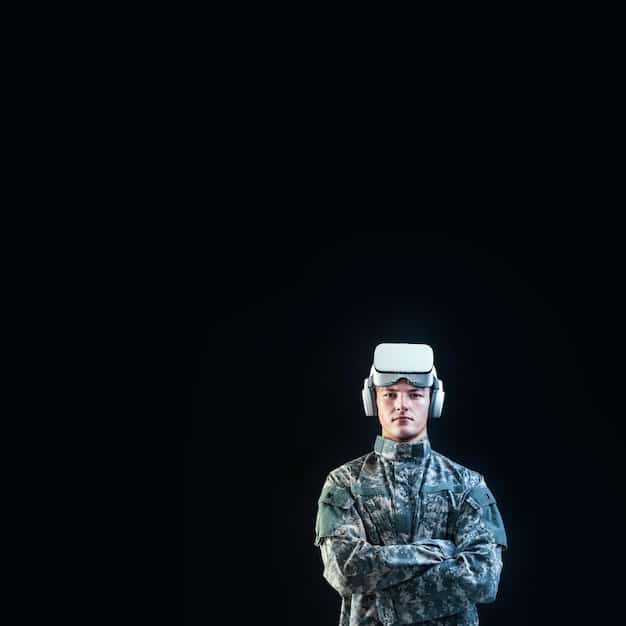Brain-Computer Interfaces: The Next Frontier in US Human-Machine Interaction

Brain-Computer Interfaces (BCIs) represent a profound leap in human-machine interaction, poised to revolutionize various sectors in the US by directly bridging the human brain with computing devices, unlocking unprecedented possibilities for communication, control, and enhancement.
Imagine a world where thought alone can control advanced prosthetics, communicate complex ideas, or even navigate digital realms. This is the promise of Brain-Computer Interfaces: The Next Frontier in US Human-Machine Interaction – a revolutionary field that is rapidly moving from science fiction to tangible reality. As technology advances, the potential for BCIs to reshape healthcare, defense, entertainment, and daily life in the United States is becoming increasingly clear, hinting at an era where the lines between human and machine blur in profound and transformative ways.
The Dawn of Direct Thought Control: What are BCIs?
The concept of directly interfacing the human brain with external devices may sound like something out of a futuristic novel, but it is precisely what Brain-Computer Interfaces (BCIs) aim to achieve. At its core, a BCI is a system that translates brain activity into commands that external devices can understand and execute. This direct communication pathway bypasses peripheral nerves and muscles, offering unprecedented control for individuals who might otherwise be limited by physical constraints, or expanding capabilities for those seeking augmented interaction.
BCIs operate by sensing and interpreting electrical signals generated by the brain, whether through invasive implants or non-invasive wearables. These signals, representing thoughts, intentions, or physiological states, are then processed by complex algorithms. The processed data is subsequently translated into actions, such as moving a robotic arm, typing on a screen, or controlling a cursor. This technology holds immense promise for various applications, fundamentally redefining how humans interact with the digital and physical world around them.
Types of Brain-Computer Interfaces
The landscape of BCI technology is diverse, broadly categorized into invasive and non-invasive methods, each with its unique advantages and challenges.
- Invasive BCIs: These systems involve surgically implanting electrodes directly into the brain. They offer the highest signal quality and precision, as the electrodes are in direct contact with neural tissue, allowing for the detection of individual neuron firing. This high fidelity makes them ideal for complex motor control and sensory feedback applications.
- Non-Invasive BCIs: These rely on external sensors placed on the scalp or forehead, such as electroencephalography (EEG). While less precise due to signal attenuation through the skull, non-invasive BCIs are safer, easier to use, and more accessible for broader applications like controlling basic computer functions or monitoring cognitive states without surgical risk.
- Partially Invasive BCIs: An emerging category, these interfaces are nestled between invasive and non-invasive methods, typically placed on the surface of the brain (electrocorticography – ECoG) but not deeply implanted. They offer a compromise between signal quality and surgical invasiveness, finding applications where better resolution than EEG is needed but full implantation is not preferred.
The development of these different types reflects a continuous effort to balance efficacy, safety, and accessibility. Each approach contributes uniquely to the expanding possibilities of direct brain-to-device communication, pushing the boundaries of what is achievable in human-machine interaction. This foundational understanding sets the stage for exploring the transformative applications of BCIs across various sectors in the US.
Rehabilitation and Healthcare: A New Paradigm for Recovery
One of the most immediate and profound impacts of Brain-Computer Interfaces in the US is unfolding within the realms of rehabilitation and healthcare. For individuals living with severe motor disabilities, neurological disorders, or those recovering from debilitating injuries, BCIs offer a revolutionary path to restored function, communication, and independence. This technology promises to transform patient care, moving beyond conventional assistive devices to systems that are intimately controlled by thought.
Consider the potential for patients with locked-in syndrome, who are fully conscious but unable to move or communicate verbally. BCIs can provide them with a voice, allowing them to spell out words, select phrases, or even navigate the internet using only their thoughts. This is not merely about basic communication; it’s about restoring a sense of agency and connection to the world that was once lost. The emotional and psychological benefits of such advancements are immeasurable, offering hope and dignity to those who have been marginalized by their physical conditions.
Advanced Prosthetics and Exoskeletons
The integration of BCIs with advanced prosthetics and robotic exoskeletons represents a significant breakthrough in restoring mobility and dexterity. Unlike traditional prosthetics, which rely on muscle contractions or mechanical switches, BCI-controlled limbs respond directly to neural signals. This allows for more natural, intuitive, and precise movements, enabling users to perform complex tasks with remarkable fluidity.
Imagine a veteran who lost a limb in combat regaining the ability to tie their shoelaces or play a musical instrument, all through direct thought. The development of haptic feedback systems within these prosthetics further enhances the experience, allowing users to “feel” the objects they are interacting with, creating a more cohesive and natural interface. Similarly, BCI-powered exoskeletons are helping paraplegic individuals stand and walk again, providing a sense of independence that was previously unattainable. These advancements are not only about physical restoration but also about psychological liberation, boosting confidence and quality of life. The next generation of these devices promises even greater integration and autonomy, pushing the boundaries of what is possible in physical rehabilitation.
The economic implications are also substantial. While initial development costs are high, the long-term benefits in reduced care needs, increased productivity, and improved quality of life for an aging population and veterans could lead to significant societal gains. Research institutions and companies across the US are heavily invested in this area, recognizing its transformative power. The development of patient-specific therapies driven by BCI technology offers a highly personalized approach to healthcare, moving away from one-size-fits-all treatments. This bespoke approach ensures that interventions are precisely tailored to an individual’s unique neurological profile, maximizing therapeutic outcomes and minimizing side effects, indicative of a new era in precision medicine.
Defense and Security: Enhancing Human Capabilities
The strategic implications of Brain-Computer Interfaces extend far beyond healthcare, making significant inroads into defense and national security sectors within the US. The ability to enhance human cognitive and motor capabilities, coupled with silent, high-speed communication, presents a transformative advantage in military operations, intelligence, and even cybersecurity. This rapidly evolving field is attracting substantial investment from government agencies, recognizing its potential to redefine the future of warfare and protection.
One of the most compelling applications is the control of unmanned aerial vehicles (UAVs) and other robotic systems. Soldiers could potentially pilot drones, manipulate robotic arms for bomb disposal, or even command ground vehicles using only their thoughts. This hands-free control would not only increase efficiency and speed but also allow operators to maintain situational awareness and perform multiple tasks simultaneously, reducing cognitive load in high-stress environments. The precision and responsiveness offered by direct neural control could be critical in time-sensitive missions where every second counts.
Augmented Soldier Performance
BCIs hold the promise of creating “augmented soldiers”—individuals whose natural abilities are enhanced through technology. This could involve direct thought communication with command centers, allowing for faster and more secure transmission of intelligence, or enhanced sensory perception, such as direct neural input from advanced optical sensors. Such capabilities would significantly improve decision-making speed and accuracy on the battlefield.
- Enhanced Communication: Silent, thought-based communication could revolutionize stealth operations, allowing units to coordinate without breaking radio silence or risking interception. This secure, internal network could also facilitate rapid information sharing within a combat team.
- Cognitive Enhancement: While still in early stages, research explores using BCIs to mitigate fatigue, improve focus, and enhance reaction times for soldiers in demanding situations. This could involve direct neural stimulation or adaptive response systems that optimize cognitive states.
- Weapon and Vehicle Control: Direct neural interfaces could allow soldiers to operate complex weapon systems or vehicles with unprecedented precision and speed, reducing training times and improving battlefield synergy.

The ethical considerations surrounding such enhancements are, of course, profound. Debates around super-soldiers, autonomy in lethal decision-making, and the nature of humanity itself are critical components of this discussion. However, the operational benefits are clear, pushing the US military towards exploring the vast potential of these technologies. The Department of Defense (DoD) has already invested heavily in BCI research, recognizing its strategic importance. The goal is not merely to create more effective soldiers but to ensure their safety and operational readiness in increasingly complex global scenarios. Future advancements might even include integration with exoskeleton suits for enhanced physical strength and endurance, further redefining the physical and cognitive limits of human performance in combat.
Entertainment and Gaming: Immersive Digital Experiences
The entertainment and gaming industries are always at the forefront of adopting cutting-edge technologies, and Brain-Computer Interfaces are no exception. The allure of truly immersive digital experiences, where the player’s thoughts directly influence the game world, is immense. BCIs promise a level of interactivity that goes far beyond traditional controllers, creating a seamless and intuitive link between the human mind and virtual reality. This potential for enhanced engagement is driving significant interest and investment from leading developers and tech giants in the US.
Imagine playing a video game where your character moves, reacts, and even casts spells simply by concentrating, or where your emotional state in a virtual environment shapes the narrative. This hands-free control opens up new avenues for gameplay, making experiences more accessible to individuals with physical limitations and adding layers of depth and realism for all players. The elimination of physical input devices could lead to entirely new genres of games, focusing more on cognitive challenges, emotional responses, and direct imaginative creation within virtual worlds.
Beyond the Controller: New Ways to Play
The impact of BCIs on gaming extends beyond simple control. It can enable dynamic adaptations within the game based on the player’s cognitive state. For example, if a player is stressed, the game might adjust difficulty or provide calming elements. Similarly, an engaged player might unlock new content or receive personalized challenges, creating a truly adaptive and responsive experience.
The integration of Brain-Computer Interfaces promises a future where entertainment is no longer just consumed but actively lived through. This intimate connection fosters a deeper sense of presence and ownership within digital environments. Esports, too, could see a radical transformation, with players leveraging mental focus and speed in ways previously unimagined. The development of haptic feedback systems, combined with BCIs, could even enable players to “feel” sensations within the virtual world, from the crunch of gravel underfoot to the impact of a blow, blurring the lines between reality and simulation. This level of immersion could redefine not only how we play but also how we interact with all forms of digital media, making entertainment a truly mind-bending experience.
Communication and Accessibility: Bridging Digital Divides
The power of Brain-Computer Interfaces to revolutionize communication and enhance accessibility is one of its most compelling aspects, particularly in the United States, where digital inclusion is a perpetual goal. For millions of individuals, existing communication methods are inadequate due to physical disabilities, neurological conditions, or speech impairments. BCIs offer a profound solution, providing a direct channel for expression that bypasses conventional motor pathways, thereby enabling more immediate and natural interaction with technology and with others.
Consider the potential for individuals suffering from amyotrophic lateral sclerosis (ALS) or cerebral palsy, who might have intact cognitive function but severely limited physical mobility. For them, BCIs can mean the difference between isolation and connection. These systems can empower users to type emails, browse the web, or even engage in full conversations using only their thoughts, significantly improving their participation in society and access to information. This technology shifts the focus from what someone cannot do physically to what they can achieve mentally, redefining independence and broadening horizons.
Expanding Reach and Inclusion
The implications of BCI technology for enhanced accessibility extend far beyond medical applications. It holds the potential to simplify complex tasks for everyone, not just those with disabilities. Imagine performing intricate design work, composing music, or navigating dense data sets with the fluidity of thought, unencumbered by keyboards or mice. This could streamline workflows and unlock new levels of creativity and productivity across various professions.
- Direct Text Input: BCIs can enable ultra-fast text input directly from thought, surpassing traditional typing speeds and allowing for more expressive and spontaneous communication. This would benefit not only individuals with motor impairments but also professionals who require rapid documentation.
- Device Control: Beyond computers, BCIs could control smart home devices, vehicles, and even personal robots, making environments more responsive and tailored to individual needs without physical interaction.
- Educational Tools: For students with learning disabilities or those who struggle with traditional input methods, BCIs could offer alternative ways to interact with educational content, process information, and demonstrate understanding, fostering a more inclusive learning environment.
This technological shift has the potential to fundamentally transform human-computer interaction, making interfaces more intuitive and natural for the general population. The move towards thought-controlled environments promises less friction in our daily digital interactions, blurring the lines between intention and action. Industries from smart home technology to advanced manufacturing are beginning to explore how BCI principles can optimize their products and processes. The future envisioned is one where technology adapts more naturally to human thought, simplifying tasks and enhancing efficiency in ways that were once only conceived in science fiction.
Ethical and Societal Considerations: Navigating the Future of BCIs
As Brain-Computer Interfaces continue their rapid advancement, particularly in the United States, the discussion inevitably turns to the ethical and societal implications of such profound technology. While the benefits in medicine, defense, and daily life are undeniable, the ability to directly access, interpret, and potentially influence the human brain raises complex questions that demand careful consideration. Navigating these uncharted waters responsibly will be crucial for ensuring that BCI technology serves humanity’s best interests.
One of the foremost concerns revolves around privacy and data security. Brain signals are intrinsically linked to an individual’s thoughts, intentions, and even emotions. How will this incredibly sensitive neural data be stored, protected, and used? Who will have access to it, and under what circumstances? The potential for misuse, from targeted advertising based on neural responses to unauthorized access of personal thoughts, raises significant alarms. Establishing robust legal frameworks and ethical guidelines for brain data privacy is paramount to prevent dystopian scenarios.
The Promise and Peril of Brain-Computer Interfaces
The debate around BCIs often hinges on balancing the extraordinary promise of the technology with its potential perils. While medical applications offer life-changing benefits, the broader societal implications require careful foresight.

The concept of “cognitive liberty”—the right to mental self-determination—emerges as a critical concern in a BCI-enabled world. This includes the right to control one’s own mental processes, to choose whether or not to connect to a BCI, and to protect one’s thoughts from external manipulation. As BCIs become more sophisticated, questions about potential neural enhancement creating a “two-tiered society,” where those with access to superior cognitive augmentation gain an unfair advantage, will also become more pressing. Addressing these issues proactively, through public discourse, policy development, and international collaboration, is essential to ensure equitable and ethical development. The US, with its leading role in BCI research and development, bears a significant responsibility in shaping this future.
The potential for psychological impacts, such as identity shifts or attachment to BCI devices, also merits attention. As humans integrate more closely with machines, understanding the psychological effects of such symbiotic relationships will be vital. Furthermore, the notion of accountability and agency in BCI-mediated actions needs to be defined. If a BCI-controlled prosthetic causes harm, who is responsible—the user, the technology, or the manufacturer? These are not trivial questions but fundamental legal and ethical dilemmas that society must confront as BCIs move into mainstream adoption. The US legal system and ethical review boards are already beginning to grapple with these complex issues, setting precedents for a world increasingly intertwined with advanced neural technologies.
The Future Landscape of BCIs in the US: Challenges and Opportunities
The trajectory of Brain-Computer Interfaces in the US is undeniably upward, poised to reshape human-machine interaction in profound ways. However, the path forward is not without significant challenges, requiring sustained innovation, considerable investment, and thoughtful ethical governance. Despite these hurdles, the sheer breadth of opportunities that BCIs present ensures continued momentum, pushing the boundaries of what is possible in various sectors. The coming decades will likely see BCIs transition from niche applications to more integrated roles in everyday life, driven by both technological breakthroughs and burgeoning societal acceptance.
One of the primary challenges ahead is the miniaturization and long-term reliability of invasive BCI devices. While current implants offer high signal fidelity, their longevity and potential for tissue reaction remain areas of active research. Similarly, enhancing the signal quality and broadening the applications of non-invasive BCIs are crucial for widespread adoption, requiring more sophisticated sensor technology and advanced signal processing algorithms. The robustness of these systems under real-world conditions, as opposed to controlled laboratory settings, will dictate their practical utility.
Accelerating Progress and Addressing Hurdles
The US healthcare system is also grappling with how to integrate BCI technologies, considering regulatory pathways, reimbursement policies, and clinical training for medical professionals. The cost of advanced BCI systems and the associated surgical procedures represent another significant barrier to widespread accessibility, demanding innovative economic models and increased insurance coverage.
- Technological Maturation: Further advancements in materials science, data processing, and artificial intelligence are critical for developing more seamless, durable, and intuitive BCI systems that can operate reliably outside of clinical environments.
- Regulatory Frameworks: The US Food and Drug Administration (FDA) and other regulatory bodies face the challenge of creating agile yet robust frameworks for the approval and oversight of BCI devices, balancing innovation with patient safety.
- Public Acceptance and Education: Overcoming public skepticism and fostering trust in BCI technology through transparent communication and educational initiatives will be vital for its widespread adoption. This includes addressing misconceptions and ethical concerns directly.
- Interoperability Standards: Developing universal standards for BCI hardware and software will be essential to ensure compatibility across different devices and applications, fostering a cohesive ecosystem for developers and users alike.
Despite these formidable challenges, the opportunities for BCIs in the US are immense. Continued government funding, private sector investment, and cross-disciplinary collaboration among neuroscientists, engineers, and ethicists are expected to accelerate progress. The potential for job creation in a new BCI industry, coupled with the societal benefits in health, defense, and communication, provides strong incentives for overcoming current hurdles. As research progresses, we can anticipate more personalized BCI systems that adapt to individual neural patterns, offering unprecedented levels of control and interaction. The ongoing dialogue around the ethical implications of this technology will also mature, leading to responsible innovation that prioritizes human well-being. Ultimately, the future of BCIs in the US promises a paradigm shift in human interaction with the technological world, moving towards a future where thought is a direct interface.
| Key Point | Brief Description |
|---|---|
| 🧠 BCI Fundamentals | Direct brain-to-device communication, translating neural signals into actionable commands for external devices. |
| 🩺 Healthcare Impact | Revolutionizes rehabilitation, prosthetics, and communication for individuals with severe disabilities. |
| 🛡️ Defense Applications | Enhances soldier capabilities, drone control, and secure communication for military and security. |
| ❓ Ethical Considerations | Raises critical questions about privacy, data security, cognitive liberty, and societal equity. |
Frequently Asked Questions about Brain-Computer Interfaces
▼
A BCI is a technology that allows a direct communication pathway between the brain and an external device. It captures brain signals, interprets them, and translates them into commands that enable users to control computers, prosthetics, or other devices using only their thoughts. This bypasses traditional motor pathways, offering transformative potential for many applications.
▼
BCIs work by detecting brain activity, typically electrical signals from neurons. Invasive BCIs use implanted electrodes for high precision, while non-invasive ones like EEGs use sensors on the scalp. These signals are then processed by algorithms that decode the user’s intended actions or cognitive states, allowing direct control over connected technology.
▼
In the US, BCIs are being applied across various sectors. Key areas include healthcare for rehabilitation and advanced prosthetics, defense for enhancing soldier capabilities and controlling military hardware, entertainment for immersive gaming experiences, and communication to provide new avenues for individuals with severe disabilities. Research also explores cognitive enhancement.
▼
Yes, BCIs raise significant ethical concerns including brain data privacy, potential for misuse of neural information, issues of cognitive liberty (the right to mental self-determination), and the potential for creating societal inequalities if access to enhancement technologies is limited. Thoughtful ethical frameworks are crucial for responsible development and deployment.
▼
The future of BCIs in the US is promising but faces challenges like miniaturization, long-term device reliability, and regulatory hurdles. Continued advancements in AI and neuroscience, coupled with substantial government and private investment, are expected to foster widespread adoption. BCIs are set to transform human-computer interaction, making it more intuitive and personalized across diverse applications.
Conclusion
The journey of Brain-Computer Interfaces from theoretical concept to tangible reality represents one of the most exciting and transformative frontiers in human-machine interaction, particularly within the United States. As we’ve explored, BCIs hold immense potential to redefine our capabilities in healthcare, offering unprecedented pathways to recovery and independence for individuals with severe disabilities. In defense, they promise to augment human performance and operational efficiency. Across entertainment and communication, BCIs are poised to create deeply immersive experiences and bridge significant digital divides, fostering greater inclusion. However, this transformative power comes with profound ethical and societal questions regarding privacy, cognitive liberty, and equitable access. Navigating these complexities thoughtfully, with robust regulatory frameworks and broad public discourse, will be paramount. The future of BCIs in the US, while still facing technological and integration challenges, promises a paradigm shift where the human mind and technology merge in ways once only imagined, pushing the boundaries of what it means to interact, communicate, and exist in an increasingly interconnected world.





